Motorola CPEI 775 User Manual
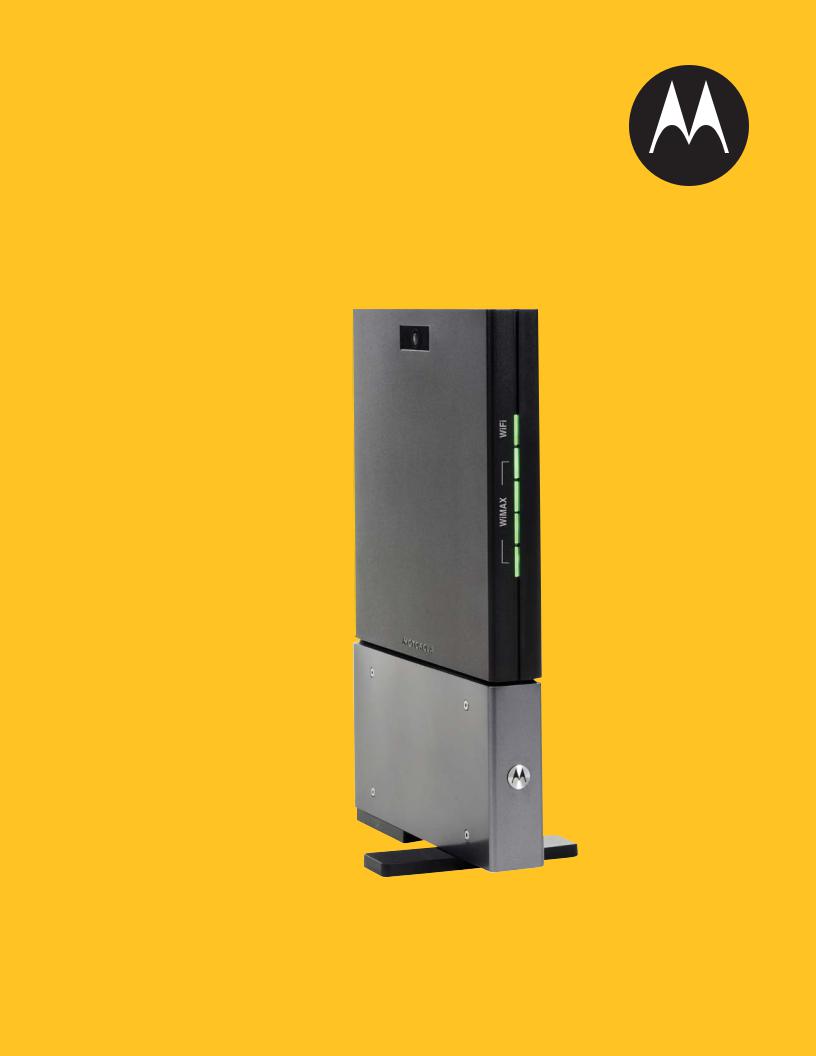
CPEi 775 Series
User Manual

Table
of
Contents
Contents
Chapter 1: Desktop CPEi 775 User Guide
Overview . . . . . . . . . . . . . . . . . . . . . . . . . . . . . . . . . . . . . . . . . . . . . . . . . . . . . . . . . . . . . . . . 1-1
Powerful Features in a Single Unit . . . . . . . . . . . . . . . . . . . . . . . . . . . . . . . . . . . . . . . . . . . . 1-2
Front of the CPE . . . . . . . . . . . . . . . . . . . . . . . . . . . . . . . . . . . . . . . . . . . . . . . . . . . . . . . . . . . 1-2
Back of the CPE . . . . . . . . . . . . . . . . . . . . . . . . . . . . . . . . . . . . . . . . . . . . . . . . . . . . . . . . . . . 1-3
Operating Information . . . . . . . . . . . . . . . . . . . . . . . . . . . . . . . . . . . . . . . . . . . . . . . . . . . . . . 1-3
Chapter 2: Installation
Overview . . . . . . . . . . . . . . . . . . . . . . . . . . . . . . . . . . . . . . . . . . . . . . . . . . . . . . . . . . . . . . . . 2-1 Before you Begin . . . . . . . . . . . . . . . . . . . . . . . . . . . . . . . . . . . . . . . . . . . . . . . . . . . . . . . . . . 2-1 Easy Setup . . . . . . . . . . . . . . . . . . . . . . . . . . . . . . . . . . . . . . . . . . . . . . . . . . . . . . . . . . . . . . . 2-1 Advanced Setup . . . . . . . . . . . . . . . . . . . . . . . . . . . . . . . . . . . . . . . . . . . . . . . . . . . . . . . . . . . 2-2 Procedure to Log into the CPE . . . . . . . . . . . . . . . . . . . . . . . . . . . . . . . . . . . . . . . . . . . . . . . . 2-2 Setup Wizard and Authentication . . . . . . . . . . . . . . . . . . . . . . . . . . . . . . . . . . . . . . . . . . . . . 2-3
Chapter 3: Basic Configuration
Personalize Menu . . . . . . . . . . . . . . . . . . . . . . . . . . . . . . . . . . . . . . . . . . . . . . . . . . . . . . . . . . 3-1
Password Tab . . . . . . . . . . . . . . . . . . . . . . . . . . . . . . . . . . . . . . . . . . . . . . . . . . . . . . . . . . . . . 3-2
Device Time Tab . . . . . . . . . . . . . . . . . . . . . . . . . . . . . . . . . . . . . . . . . . . . . . . . . . . . . . . . . . . 3-2
Device Name Tab . . . . . . . . . . . . . . . . . . . . . . . . . . . . . . . . . . . . . . . . . . . . . . . . . . . . . . . . . . 3-2
Restore Factory Settings Tab . . . . . . . . . . . . . . . . . . . . . . . . . . . . . . . . . . . . . . . . . . . . . . . . . 3-3
Internet Menu . . . . . . . . . . . . . . . . . . . . . . . . . . . . . . . . . . . . . . . . . . . . . . . . . . . . . . . . . . . . 3-3
WiMAX Security Tab . . . . . . . . . . . . . . . . . . . . . . . . . . . . . . . . . . . . . . . . . . . . . . . . . . . . . . . 3-4
Firewall Tab . . . . . . . . . . . . . . . . . . . . . . . . . . . . . . . . . . . . . . . . . . . . . . . . . . . . . . . . . . . . . . 3-4
Dynamic DNS Tab . . . . . . . . . . . . . . . . . . . . . . . . . . . . . . . . . . . . . . . . . . . . . . . . . . . . . . . . . 3-5
Status Menu . . . . . . . . . . . . . . . . . . . . . . . . . . . . . . . . . . . . . . . . . . . . . . . . . . . . . . . . . . . . . . 3-5
Telephony Menu . . . . . . . . . . . . . . . . . . . . . . . . . . . . . . . . . . . . . . . . . . . . . . . . . . . . . . . . . . . 3-6
Wi-Fi . . . . . . . . . . . . . . . . . . . . . . . . . . . . . . . . . . . . . . . . . . . . . . . . . . . . . . . . . . . . . . . . . . . 3-13
Wi-Fi Menu . . . . . . . . . . . . . . . . . . . . . . . . . . . . . . . . . . . . . . . . . . . . . . . . . . . . . . . . . . . . . . 3-13
Chapter 4: Advanced Configuration
Port Forwarding Menu . . . . . . . . . . . . . . . . . . . . . . . . . . . . . . . . . . . . . . . . . . . . . . . . . . . . . . 4-1
Forwarding Tab . . . . . . . . . . . . . . . . . . . . . . . . . . . . . . . . . . . . . . . . . . . . . . . . . . . . . . . . . . . 4-2
Local Address Menu . . . . . . . . . . . . . . . . . . . . . . . . . . . . . . . . . . . . . . . . . . . . . . . . . . . . . . . . 4-2
DHCP Server Tab . . . . . . . . . . . . . . . . . . . . . . . . . . . . . . . . . . . . . . . . . . . . . . . . . . . . . . . . . . 4-3
Lease Status Tab . . . . . . . . . . . . . . . . . . . . . . . . . . . . . . . . . . . . . . . . . . . . . . . . . . . . . . . . . . 4-4
Lease Reservation Tab . . . . . . . . . . . . . . . . . . . . . . . . . . . . . . . . . . . . . . . . . . . . . . . . . . . . . . 4-4
Control Panel . . . . . . . . . . . . . . . . . . . . . . . . . . . . . . . . . . . . . . . . . . . . . . . . . . . . . . . . . . . . . 4-5
Software Tab . . . . . . . . . . . . . . . . . . . . . . . . . . . . . . . . . . . . . . . . . . . . . . . . . . . . . . . . . . . . . 4-6
68P09301A65-A |
i |
FEB 2009 |
|
Certificate Tab . . . . . . . . . . . . . . . . . . . . . . . . . . . . . . . . . . . . . . . . . . . . . . . . . . . . . . . . . . . . 4-6
System Tab . . . . . . . . . . . . . . . . . . . . . . . . . . . . . . . . . . . . . . . . . . . . . . . . . . . . . . . . . . . . . . . 4-6
About Tab . . . . . . . . . . . . . . . . . . . . . . . . . . . . . . . . . . . . . . . . . . . . . . . . . . . . . . . . . . . . . . . . 4-7
Wi-Fi Advanced . . . . . . . . . . . . . . . . . . . . . . . . . . . . . . . . . . . . . . . . . . . . . . . . . . . . . . . . . . . 4-7
Chapter 5: Configuring TCP/IP
Configuring TCP/IP in Windows XP . . . . . . . . . . . . . . . . . . . . . . . . . . . . . . . . . . . . . . . . . . . . 5-1
Configuring TCP/IP in Windows Vista . . . . . . . . . . . . . . . . . . . . . . . . . . . . . . . . . . . . . . . . . . 5-5
Chapter 6: Troubleshooting
Power . . . . . . . . . . . . . . . . . . . . . . . . . . . . . . . . . . . . . . . . . . . . . . . . . . . . . . . . . . . . . . . . . . . 6-1 A Computer Cannot Log On to the CPE . . . . . . . . . . . . . . . . . . . . . . . . . . . . . . . . . . . . . . . . . 6-1 Cannot Connect to the Internet . . . . . . . . . . . . . . . . . . . . . . . . . . . . . . . . . . . . . . . . . . . . . . . 6-1 Additional Troubleshooting Help . . . . . . . . . . . . . . . . . . . . . . . . . . . . . . . . . . . . . . . . . . . . . . 6-1
Chapter 7: Important Safety and Legal Information
This Product complies with the following RF energy exposure standards and guidelines: . . 7-1 RF Exposure Compliance and Guidelines Operating Instructions . . . . . . . . . . . . . . . . . . . . . 7-1 FCC Regulatory Information . . . . . . . . . . . . . . . . . . . . . . . . . . . . . . . . . . . . . . . . . . . . . . . . . 7-1 Industry Canada Statement . . . . . . . . . . . . . . . . . . . . . . . . . . . . . . . . . . . . . . . . . . . . . . . . . . 7-2 EU Declaration of Conformity . . . . . . . . . . . . . . . . . . . . . . . . . . . . . . . . . . . . . . . . . . . . . . . . 7-3 Caring for the Environment . . . . . . . . . . . . . . . . . . . . . . . . . . . . . . . . . . . . . . . . . . . . . . . . . . 7-3 Disposal of Motorola Equipment in EU Countries . . . . . . . . . . . . . . . . . . . . . . . . . . . . . . . . . 7-4 Disposal of Motorola Networks Equipment in Non-EU countries . . . . . . . . . . . . . . . . . . . . . 7-4 CMM Disclosure . . . . . . . . . . . . . . . . . . . . . . . . . . . . . . . . . . . . . . . . . . . . . . . . . . . . . . . . . . . 7-4 Copyrights and Trademarks . . . . . . . . . . . . . . . . . . . . . . . . . . . . . . . . . . . . . . . . . . . . . . . . . . 7-5 Copyrights . . . . . . . . . . . . . . . . . . . . . . . . . . . . . . . . . . . . . . . . . . . . . . . . . . . . . . . . . . . . . . . 7-5 Usage and Disclosure Restrictions . . . . . . . . . . . . . . . . . . . . . . . . . . . . . . . . . . . . . . . . . . . . . 7-5
ii |
68P09301A65-A |
|
FEB 2009 |
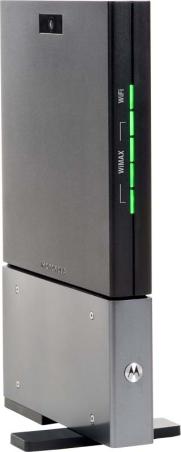
Desktop CPEi 775 User Guide |
1 |
Chapter 1: Desktop CPEi 775 User Guide
Overview
Thank you for purchasing the Motorola CPE Indoor (CPEi) 775 desktop device. The Desktop CPEi allows you to connect to the wireless world easily and seamlessly without complicated installation and setup procedures. In addition, it offers you the ability to make Voice over Internet Protocol (VoIP) calls.
The Desktop CPE indoor (CPEi) device provides the user:
•Convenience - with easy plug and play functionality. Compact design.
•Control - remote management capability allows easy detection and authentication once the unit is set up.
•VoIP - two RJ11 ports allow for Voice over IP calls using your CPEi 775.
•Wi-Fi - wireless LAN
The features and the physical appearance of your Desktop CPEi device may differ slightly from the illustration.
Figure 1-1: CPEi 775
For the most recent documentation, visit the Product Documentation page on
www.motorola.com.
68P09301A65-A |
1-1 |
FEB 2009 |
|
1 |
Desktop CPEi 775 User Guide |
Powerful Features in a Single Unit
The CPE device provides the following features:
•WiMAX Authentication
•WAN DHCP Client
•LAN DHCP Server
•Home Gateway Functions
•Firewall Protection
•Port Forwarding
•Wi-Fi
Front of the CPE
The front of the CPE unit contains LED Link/Activity indicators. The LEDs show the status of the initialization during and network connections during power up. The LEDs also indicate the signal strength, and if Wi-Fi is enabled.
Table 1-1 LED Indicator Interface
LED |
Status |
Wi-Fi |
Indicates if Wi-Fi is enabled or disabled. |
|
LED on, Wi-Fi is enabled. |
|
|
Signal Strength |
Full WiMAX Signal Strength is detected |
|
when all WiMAX Signal Strength LEDs are |
|
lit. |
|
• One to two WiMAX Signal Strength |
|
LEDs are lit - low signal detected. |
|
• Three to five WiMAX Signal Strength |
|
LEDs are lit - high signal detected. |
|
|
WAN WiMAX |
While acquiring access to the WiMAX |
|
Network: |
|
• All WiMAX Signal Strength LEDs vary |
|
between ON, OFF and/or BLINKING |
|
status. |
|
|
1-2 |
68P09301A65-A |
|
FEB 2009 |
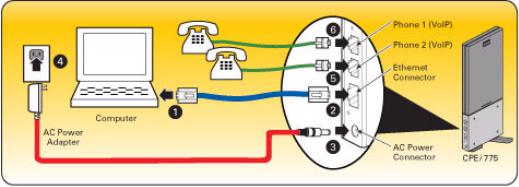
Desktop CPEi 775 User Guide |
1 |
Back of the CPE
The back of the CPE unit contains the reset switch, AC Power Connector, Ethernet connector, Ethernet LED, Line 1 and Line 2 telephone ports.
Figure 1-2: CPE Ports and Connections
Table 1-2 Port Descriptions
Port |
Port Description |
Ethernet |
Ethernet Port |
|
|
Power |
AC Power Connector |
|
|
Reset |
Hardware Reset Button (A paperclip is |
|
recommended for accessing this button). |
|
|
Phone Line 1 |
RJ-11 port for use with VoIP. |
|
|
Phone Line 2 |
RJ-11 port for use with VoIP. |
|
|
Operating Information
Operating temperature for this unit is 0-40°C (32-104°F).
68P09301A65-A |
1-3 |
FEB 2009 |
|
1 |
Desktop CPEi 775 User Guide |
1-4 |
68P09301A65-A |
|
FEB 2009 |
Installation |
2 |
Chapter 2: Installation
Overview
To install the Desktop CPEi 775 Series, review the following sections:
•Before You Begin
•Easy Setup
Before you Begin
Before you begin installation, check that you have received the following items with your Desktop CPEi 775:
Table 2-1 In the box with your CPE, you should have
Item |
Description |
AC Power Adapter |
Power adapter cord connects the Desktop |
|
CPE to an AC electrical outlet. |
|
|
Ethernet Cable |
The Ethernet cable connects the Internet |
|
port on your Desktop CPE to your PC or |
|
laptop computer. |
|
|
Desktop CPEi 775 Quick Start Guide |
Desktop CPEi 775 Quick Start Guide |
|
|
In addition, you need:
•A computer
•An RJ-11 telephone cable (optional). Two RJ-11 telephone cables are required if your service provider has supplied you with two telephone numbers.
Easy Setup
The CPE is easily set up in your home. Basic installation equipment needed are the power adapter and cord, Ethernet cable, a PC or laptop computer and the CPE device. If you want to use the VoIP functionality, you need an RJ-11 phone cable and a telephone.
Perform the following tasks before attaching the power cord or powering up the unit:
•Stand the CPE on a flat surface.
•Plug the AC power adapter cord into an AC outlet.
•Plug one end of the Ethernet cable into the Ethernet connector on the back of the unit.
•Plug the other end of the Ethernet cable into the Ethernet connector of your computer.
•To use VoIP functionality of the phone, plug one end of the phone line into the activated phone connector on the back of the unit. Phone line activation is dependent upon your service contract.
•Plug the other end of the phone line into the phone line connector of your telephone.
68P09301A65-A |
2-1 |
FEB 2009 |
|

2 |
Installation |
Advanced Setup
The CPE can also be used to connect to a multi-port switch (hub) - purchased separately from the CPE. Connecting the CPE device to a hub allows you to connect more than one computer to your CPE device.
Procedure to Log into the CPE
Before you Begin Configuration
Some settings on your computer need to be verified or changed to ensure that your computer configuration can support the Desktop CPE.
Verify that the IP addresses and DNS settings are automatically generated in your Local Area connection of your Internet Protocol (TCP/IP) properties. Refer to the chapter titled “Configuring TCP/IP” for additional information.
Logging in to the CPE
Use the following procedure to log into the Desktop CPE:
1.On a computer that is connected to the Desktop CPE, open a web browser.
2.In the Address or Location field, type http://mywimax. and press ENTER to display the login screen.
Include the period (.) after http://mywimax. in order to access the login screen.
 NOTE
NOTE
Enter the IP address: http://192.168.15.1 into Address field in order to gain access to your CPE. If you cannot access the CPE, refer to the chapter titled: Configuring TCP/IP for more information.
3.The Welcome to Motorola WiMAX CPE screen is displayed and prompts you for a password.
2-2 |
68P09301A65-A |
|
FEB 2009 |
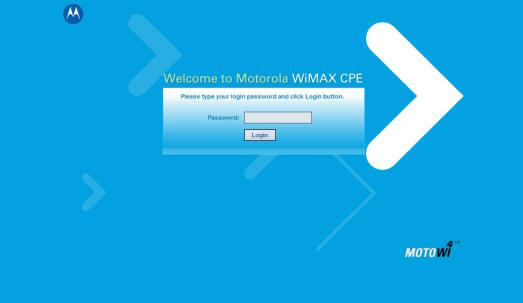
Installation |
2 |
Figure 2-1: Login Screen
4.In the Password field, type the password (default is motorola).
5.Click Login.
6.First time users see a pop-up box that states: “The Wizard application will guide you through for the first time configuration”. Click OK button to continue.
7.Click the OK button to launch the wizard application.
Setup Wizard and Authentication
Step 1 - Change Password
Once you have launched the setup wizard, you are prompted to change your password. Motorola recommends using a password to protect your home network and CPE device. Passwords are case sensitive.
To change your password:
•Ensure the “Enable Login Password Protection” box is checked.
•Enter a New Login Password in the box. Passwords can be no more than 20 characters in length.
•Re-type your new password in the Confirm New Login Password box.
•Click Next.
If you forget your password, you can reset it back to the default (motorola) password. To reset the password, press and hold the reset button on the back of your CPE for 5 or more seconds. Before resetting the CPE, ensure that the power is ON.
Step 2 - Device Time
This screen allows you to set the time zone and to enable Daylight Savings Time (when applicable) for your location.
•Select the appropriate time zone for your location from the drop-down box.
68P09301A65-A |
2-3 |
FEB 2009 |
|
2 |
Installation |
•Check the box that is called “Auto Adjust for Daylight Savings Time” if you live in a region that observes Daylight Savings Time. This box is checked by default.
•Click the Next button.
Step 3 - WiMAX Security
The WiMAX Security tab contains your authentication method. Check with your service provider to determine if they require a user name and password for authentication purposes.
•If the Authentication Method is EAP-TLS, no User Name and Password are required. Enter the Realm information supplied by your service provider. Click the Next button.
•If the Authentication Method is EAP-TTLS/MS-CHAPv2, enter a User Name and Password, and Realm information supplied by your Service Provider. Once you have entered the User Name/Password/Realm information, click the Next button.
•If you are unsure of the Authentication Method, select EAP-TLS (which is the default) and click the Next button.
Step 4 - Account
The Account tab allows you to manage Voice over IP (VoIP) related services. Please consult with your telephony service provider for these settings.
Click the Apply button when finished.
Congratulations! You have now completed the setup of your WiMAX connection. Click OK on the Congratulations! dialog box.
A status screen appears that shows Network status and telephony status. The Network Status screen provides any status associated with your WiMAX Wireless Broadband connection. The Telephony Status screen provides status of your telephony service.
•The Restart button is used to restart the device. The restart button is available on every screen.
•The Wizard button starts the set-up wizard over again.
•The Refresh button refreshes the screen with the current status.
•The Auto Refresh button allows the web browser to automatically refresh at the interval determined in the Control Panel menu.
2-4 |
68P09301A65-A |
|
FEB 2009 |
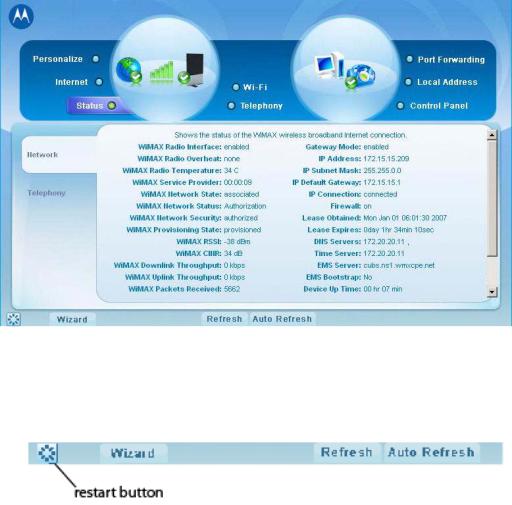
Installation |
2 |
Figure 2-2: Status Screen
Restart Button
Figure 2-3: Restart Button
68P09301A65-A |
2-5 |
FEB 2009 |
|
2 |
Installation |
2-6 |
68P09301A65-A |
|
FEB 2009 |
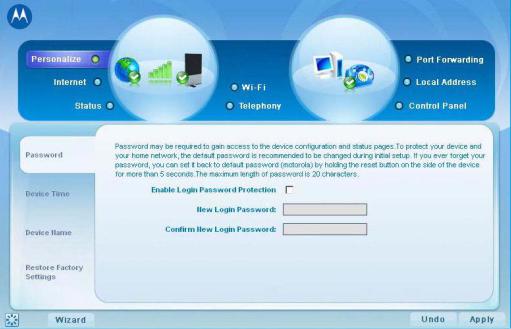
Basic Configuration |
3 |
Chapter 3: Basic Configuration
Once the CPE setup has been completed, you can log in to your CPE from any computer on your home network. To log in type the device name in the address bar on your computer. The default device name is mywimax.
This section describes the PERSONALIZE, INTERNET, STATUS, and Wi-Fi basic Menus that are available.
Personalize Menu
The Personalize menu provides the following tabs:
•Password
•Device Time
•Device Name
•Restore Factory Settings
Figure 3-1: Personalize Menu
68P09301A65-A |
3-1 |
FEB 2009 |
|
3 |
Basic Configuration |
Password Tab
The password tab allows you to enable/disable password protection. You can also change your password here. Be sure to click the Apply button when finished
.
Table 3-1 Password Tab
Field or Button |
Description |
Enable Login Password Protection |
Checking this box requires login password |
|
protection. |
|
|
New Login Password |
Enter your new password here. Maximum |
|
20 characters. Passwords are case |
|
sensitive. |
|
|
Confirm New Login Password |
Re-enter your new password here, exactly |
|
as entered in the previous step. |
|
|
Device Time Tab
The Device Time tab allows you to establish the time zone for your location. It also allows you to automatically adjust for Daylight Savings Time if necessary. Be sure to click the Apply button when finished.
Table 3-2 Device Time Tab
Field or Button |
Description |
Current Local Time |
Current Local Time |
|
|
Time Zone |
Select your local time zone from the drop- |
|
down box. |
|
|
Auto Adjust for Daylight Saving Time |
Check this box if your location observes |
|
Daylight Savings Time. (Default is |
|
checked) |
|
|
Device Name Tab
The Device Name tab allows you to rename your CPE device. The Device Name is the name you enter on an internet browser address bar to access your CPE device. Be sure to click the Apply button when finished.
Table 3-3 Device Name Tab
Field or Button |
Description |
New Device Name |
Enter the new name for the CPE device. |
|
Maximum 20 characters. |
|
|
3-2 |
68P09301A65-A |
|
FEB 2009 |
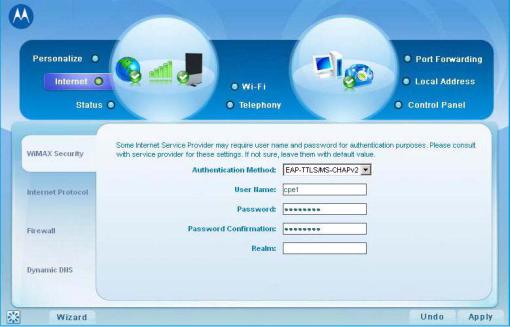
Basic Configuration |
3 |
Restore Factory Settings Tab
The Restore Factory Settings Tab resets your CPE to the manufacturers default settings. Be sure to click the Apply button if you are sure that you want to reset factory settings.
Table 3-4 Restore Factory Settings Tab
Field or Button |
Description |
Restore Factory Settings |
Checking this box restores the CPE to |
|
factory default settings. The device |
|
restarts when you click Apply. |
|
|
Internet Menu
The Internet menu provides the following tabs:
•WiMAX Security
•Internet Protocol
•Firewall
•Dynamic DNS
Figure 3-2: Internet Menu
68P09301A65-A |
3-3 |
FEB 2009 |
|
3 |
Basic Configuration |
WiMAX Security Tab
The WiMAX Security tab contains your authentication method. Check with your service provider to determine a user name and password are required for authentication purposes.
Table 3-5 WiMAX Security Tab
Field or Button |
Description |
Authentication Method |
Drop down box allows you to select either |
|
EAP-TLS (default) or EAP-TTLS/MS- |
|
CHAPv2. |
|
|
User Name (EAP-TTLS/MS-CHAPv2 only) |
Enter the User Name supplied by your |
|
service provider. |
|
|
Password (EAP-TTLS/MS-CHAPv2 only) |
Enter the Password supplied by your |
|
service provider. |
|
|
Realm |
Supplied by your service provider. |
|
|
If your authentication method is EAP-TLS, then a User Name and Password are not necessary.
Click the Apply button.
Internet Protocol Tab
Please check with your service provider for these settings. If you are unsure of the settings, leave the default values set and click the Apply button.
If your service provider has instructed you to change any of these settings, be sure to click the Apply button when you are finished.
Firewall Tab
A firewall helps to protect your home network from unauthorized access. It also helps to manage authorized access from the internet to your CPE.
Table 3-6 Firewall Tab
Field or Button |
Description |
Enable Firewall |
Check this box to enable the firewall for |
|
your home network. |
|
|
Enable Web Login from Internet |
(Grayed out if Enable Firewall is not |
|
selected). |
|
Check this box to enables you to access |
|
your CPE device from a network other |
|
than your own. |
|
|
Web Login Port from Internet |
Choose a port number to connect to when |
|
logging in from a network other than your |
|
own. The default is 8080. |
|
|
3-4 |
68P09301A65-A |
|
FEB 2009 |
Basic Configuration |
3 |
Table 3-6 Firewall Tab
Field or Button |
Description |
Enable ping from Internet |
Enables the CPE to respond to a ping from |
|
the Internet. This option would be enabled |
|
to allow testing only. Do not leave this |
|
enabled. |
|
|
Be sure to click the Apply button once you are finished.
Dynamic DNS Tab
Dynamic Domain Name Service (DDNS) allows a user with a non-static IP address to keep their domain name associated with an ever changing IP address. As an example, DDNS is used when you are hosting your own website.
Table 3-7 Dynamic DNS Tab
Field or Button |
Description |
Enable DDNS |
Check this box to Enable DDNS (default is |
|
unchecked). |
|
|
DDNS Service Provider |
Select DDNS Service Provider that you |
|
belong to from the drop-down box. |
|
|
DDNS User Name |
Only valid if Enable DDNS is checked. |
|
Enter your DDNS account user name. |
|
|
DDNS Password |
Only valid if Enable DDNS is checked. |
|
Enter your DDNS account password. |
|
|
DDNS Host Name |
Only valid if Enable DDNS is checked. |
|
Enter the DDNS Host Name. This is |
|
assigned by the DDNS service. |
|
|
Be sure to click the Apply button once you are finished.
Status Menu
The Status menu provides the following tabs:
•Network
•Telephony
68P09301A65-A |
3-5 |
FEB 2009 |
|
